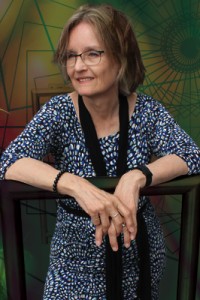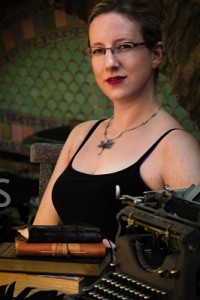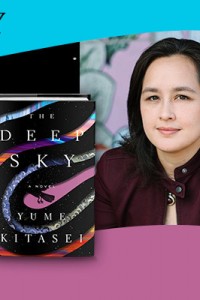Daniel Abraham: The Aspects of Epic

Daniel James Abraham was born November 14, 1969 in Albuquerque NM and attended University of New Mexico, where he earned a degree in biology. After graduating in 1996, he spent a few months in New York working at a bookstore, then returned to New Mexico and spent ten years in tech support. He now writes full time.
He is probably best known as half of “James S.A. Corey,” the pseudonym for his collaborations with Ty Franck. (The first and last name are Abraham’s and Franck’s middle names, respectively, and the middle initials are those of Abraham’s daughter.) They began their SF series the Expanse with Leviathan Wakes in 2011, and the ninth and final novel, Leviathan Falls, was published this year. The Expanse won the Hugo Award for Best Series in 2019, and the popular television adaptation recently concluded after six seasons. The two are currently collaborating on a new space opera series.
Abraham’s first story was “Mixing Rebecca” in 1996, followed by sales to various magazines and anthologies. Notable stories include Nebula Award finalist and International Horror Guild Award winner “Flat Diane” (2004) and World Fantasy and Hugo Award finalist “The Cambist and Lord Iron: A Fairytale of Economics” (2007). Some of his short work has been collected in Leviathan Wept and Other Stories (2010). Novella “Shadow Twin” (2004), written with George R.R. Martin & Gardner Dozois, formed the basis for their collaborative novel Hunter’s Run (2008).
Abraham’s debut novel was A Shadow in Summer (2006), first in the Long Price fantasy quartet, which also includes A Betrayal in Winter (2007), An Autumn War (2008), and The Price of Spring (2009). The Dagger and the Coin series is The Dragon’s Path (2011), The King’s Blood (2012), and The Tyrant’s Law (2013), The Widow’s House (2014), and The Spider’s War (2016). As M.L.N. Hanover, he wrote the Black Sun’s Daughter series: Unclean Spirits (2008), Darker Angels (2009), Vicious Grace (2010), Killing Rites (2011), and the Graveyard Child (2013). He wrote six-issue comic book miniseries George R.R. Martin’s Wild Cards: The Hard Call (2008) and the comic adaptations of Martin’s Skin Trade, Fevre Dream and A Game of Thrones.
His new solo series, the unconventional epic fantasy Kithmar trilogy, recently launched with Age of Ash (2022).
Abraham lives in Albuquerque with wife Katherine Abraham (married 2002) and their daughter Scarlet, born 2006.
Excerpt from the interview:
“Age of Ash is the first of a trilogy – a structurally pretty weird trilogy for me. It’s a very different project than things I’ve done before. It’s that epic fantasy that I grew up reading, like Thieves’ World and Fafhrd and the Gray Mouser, that part of my reading history.
“The story itself is about a fantasy city that rhymes with Lankhmar and Sanctuary and those places. This book is about two young women working through different kinds of grief in the course of this epic fantasy story, with intrigue and violence and crime and all of the stuff you come to fantasy for.
“The original name for the project was The Aspects of Kithamar. I’m playing with different kinds of ideas of what ‘epic’ is. The Kithamar Trilogy, Age of Ash and the next two, are about a different epic than the one that I’m used to playing with. I did a weird version of epic fantasy with The Long Price Quartet – that was going over a whole lifetime, which is what gave it the epic feel. Then I did The Dagger and the Coin, and that was a traditional epic: big wars, going to the core of the genre. This new series is something I haven’t seen before, where it’s an epic of depth in a place, so it’s a really constrained trilogy.
“It’s set in one city, over one year, with three stories happening simultaneously that sometimes touch each other, but they’re really each their own thing. Age of Ash is the one about grief, about the folks who are most on the margins of that city, the ones who are scraping to get by. It’s about the city that they see, and the city as they see it. I’m almost done with the second book now, and that one is the city as somebody else sees it, and it’s a very different city for them. The third one is going to be from a different perspective, and it’s also a very different city.
“The idea is to acknowledge that sense of being in a room full of people, and everybody in there is part of their own story, and there’s no way, even if you knew everybody in there and you understood as much as we can understand about each other, there’d still be no way to access the depth of experience that’s going on in any person’s mind. Go to any convention, any mid-sized room, and see who’s in the audience, and there are so many stories and experiences in that room that are invisible to us.
“It was really fun hanging out with those characters and being in that story. It’s weird writing epic fantasy and thinking about what epic fantasy stories are, and engaging with that or not engaging with it. There’s an old Fritz Leiber story called ‘The Price of Pain-Ease’ that has Fafhrd and Gray Mouser dealing with grief and memory, and I’m sure that story’s DNA wound up in my book. That I can remember that story and its title when I haven’t read it in two or three decades, that means it was important to me, right?
“We wind up imagining the world through a particular lens, and as writers we’re imagining a person and imagining those moments and trying to capture them, and trying to transcribe them in a way that other people will understand. That’s the fun part of the gig. There’s this universality of experience, right? Where you think, ‘Okay, well, she’s doing this thing; if I were not my best self, and I were in the same place, how would I fuck up?’ I look back at the earlier stages of my life, when I was inappropriately infatuated with somebody: what kind of asshole did that make me? What vulnerability did I have in that moment? What anger in that moment, and what resentment came out of that? How did my feelings present? As a writer, you mine all of that. The things Sammish and Alys are going through are not things that I’ve done, but they rhyme with experiences that I’ve had, because they have to. I’m middle aged now; I’m 52, so I’ve done a bunch of stuff, and I’ve got a pretty good toolbox at this point.
“The way that Age of Ash is about grief, the second book is about romance. It’s not a romance in the sense of, ‘There’s a boy and a girl and they hate each other and fall in love by the end’ or, ‘They love each other at the beginning and die by the end,’ or any of the other traditional arcs there. It’s about two particular characters going through their particular relationship and informing the city around them, and the city informing them. That ties in with the magic system that I hint at in the first book, and I get to explain some more, and it ties in with the idea of relationships and of being in community.
“In the first book, you meet both of the characters who are featured in the next book, and you’ll see some of the critical things that happen in that story in the background of the first book. Almost no point-of-view character in the first book is a POV character in the second book, though. Each book covers the same year, and they happen at the same time. When there’s a windstorm in one book, there’s going to be a windstorm in the other. When a boat sinks in one, the boat’s going to sink in the other, and when there’s a plague scare in one, there’s going to be a plague scare in the other. Where those events fit into the foreground or background of a given book depends on who is telling the story.
“I had to think about balancing that: ‘Okay, here’s a scene where all the protagonists of all three books are in the same space at the same time. How much are they going to overhear of the other person’s conversation? What are they going to misunderstand about each other?’ There are some lynchpin moments all throughout the books that are made up of these critical moments. When I was talking to friends about this, people kept talking about Rashomon, which is not actually what this is, because Rashomon is about taking one central question and then seeing it from all different points of view. This is about seeing things from all different points of view, but it’s not about the same central issue. The questions that come up with Alys and Sammish are related to their story, and I hope they come to an ending that is satisfying in book one. The issues that come up in the next book are going to come to their own endings, and they’re going to touch the stories on the other sides of them. Then the third story is going to have these other characters, and the stories and the issues they’re dealing with are going to be informed by what you know, and informed by the same city and the same events, but they’ll mean something different because they’re part of a different story.
“Ideally, it’s not going to matter what order you read these books in. There’s a story about grief, a story about love, and a story about history – whatever order you read them in, they should all stand by themselves. If you don’t read Age of Ash, and you pick up the second book, it should work as a standalone, and if you don’t pick up the first two, the third book should work, too. Then when you go back and read the others you’ll still have the same experience: ‘Oh, this is deep; oh, I remember that; oh, this would be confusing if you saw it from the other perspective.’ Ideally, it’s three standalone books that tell their own stories, and when you fit them all together they tell a different story. They don’t rely on each other, but inform each other, and then form part of something bigger. Writing these was really challenging, but I don’t want to get bored.
“My original plan was for a five-book series, and they cut it down to three because it seemed unwieldy. I was going too big. Three is fine, but it was always the idea of standalone stories that echo against each other. It’s hard for me. My experience reading it is not the same as anybody else’s experience because I have a different experience with the text, but until you’ve read at least two of them, you can’t see what the project is. And that’s why it’s important that each works by itself. There’s a really interesting craft conversation about accessibility that I don’t hear a lot. I don’t go to conventions as much as I used to these last few years, but when I was in that scene, the idea of how to make a story accessible – just from the perspective of an artist – that’s a really deep and complicated question.
Interview design by Stephen H. Segal.
This report and more like it in the July 2022 issue of Locus.
 While you are here, please take a moment to support Locus with a one-time or recurring donation. We rely on reader donations to keep the magazine and site going, and would like to keep the site paywall free, but WE NEED YOUR FINANCIAL SUPPORT to continue quality coverage of the science fiction and fantasy field.
While you are here, please take a moment to support Locus with a one-time or recurring donation. We rely on reader donations to keep the magazine and site going, and would like to keep the site paywall free, but WE NEED YOUR FINANCIAL SUPPORT to continue quality coverage of the science fiction and fantasy field.
©Locus Magazine. Copyrighted material may not be republished without permission of LSFF.








